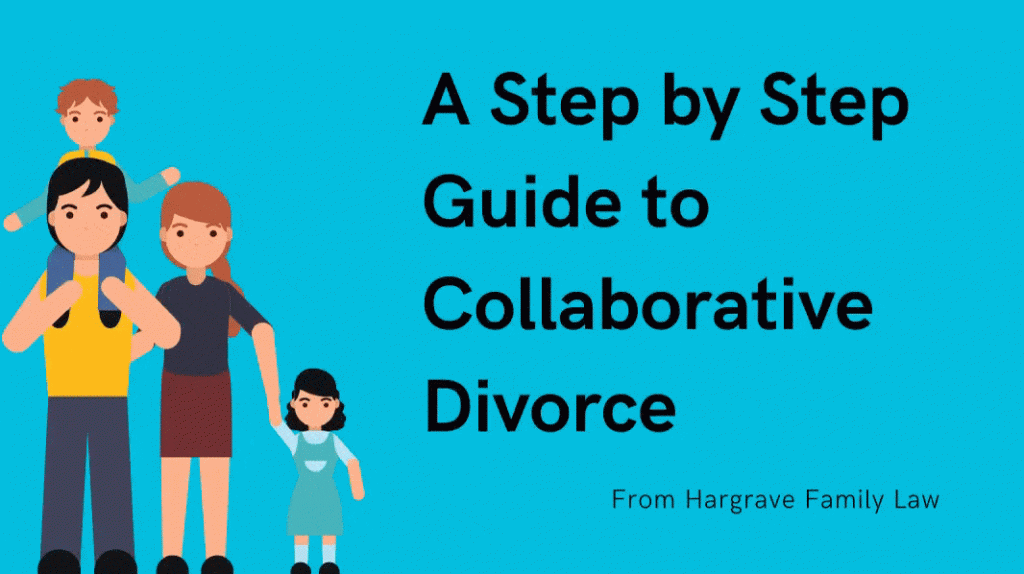Ultimate Guide to Collaborative Divorce
If you find yourself at a place in your marriage where you and your spouse are considering divorce, you may have heard about a unique process called Collaborative Divorce. This guide is meant to serve you in your search for the appropriate process to find a resolution to your marital issues.
Our founding attorney, Jennifer Hargrave, is a longtime proponent of the Collaborative Process. she has been called upon to teach at collaborative conferences such as the International Association of Collaborative Professionals, Collaborative Divorce Texas events and other civil collaborative law trainings. She was also a contributing author to the leading book on collaborative divorce in Texas, Collaborative Law – Start to Finish, published by the State Bar of Texas.
We hope this guide is useful to you in gaining further clarity around Collaborative Divorce.
What is a Collaborative Divorce?
In this video, Jennifer Hargrave explains what the concept of Collaborative Divorce is.
At a glance, a collaborative divorce allows couples who are beginning the divorce process to make commitments to each other that they’re going to work together to resolve the issues that need to be settled instead of going to court and litigating the issues in front of the judge.
There are a number of unique aspects to the collaborative process, and to start, we’ll look at some key benefits to a collaborative divorce.
We find that our clients who engage the collaborative divorce process enjoy the perfect privacy it provides for their families and they enjoy the control.
Jennifer Hargrave
Hargrave Family Law
What are the benefits of a collaborative divorce?
While a collaborative divorce may not be appropriate for every couple, there are definitely some key benefits.
In this video Jennifer Hargrave describes 3 core benefits of a Collaborative Divorce to help you make a decision on if this unique process is right for your situation.
COLLABORATIVE DIVORCE HAPPENS OUTSIDE THE COURTS
one of the core distinctions of collaborative divorce is that it operates 100% outside of the court system. There are no hearings in the court, and you do not sit in front of a judge at any time.
The closest you get to a court is when both parties come to a settlement and it’s time to file the divorce papers and settlement agreement. However, since this takes place end of the collaborative process this is a simple, uncontested procedure.
A COLLABORATIVE DIVORCE PROCESS IS PRIVATE
Since a collaborative divorce takes place outside the court system, the entire process is private to the parties involved. This is an important consideration for considerations regarding the children of the parties involved, or for parties that have significant financial and material assets.
The information you share during collaboration cannot be used in court if either party decides to terminate the collaborative process and go through the litigation process. In this way collaborative divorce is designed to protect both parties, as they endeavor to find a mutually agreed upon conclusion.
COLLABORATIVE DIVORCE PROCESS IS FOCUSED ON YOUR FUTURE (NOT YOUR PAST)
Instead of being tied up with things that have happened in your past, collaborative divorce looks forward to what you need for you and your family so that you can have the best life after your divorce.
You Can Avoid Unnecessary Conflict
The core of the Collaborative Divorce process is that you are moving from an adversarial “fight and win” approach to a “problem resolution” approach. In this way, the collaborative process avoids the typical conflict and adversity that are a part of traditional divorce proceedings.
It’s important to note, however, that both parties need to be committed to the process for it to be effective.
It’s Family Centered
In addition to the private nature of a collaborative divorce, families who undertake this process usually involve mental health professionals, financial professionals, and child custody specialists who are all “party-neutral”. This is important for families, as it makes sure that the process is focused on resolving conflicts in a way that is less traumatic for children, and focused on their long term well-being.
It’s Customized
The collaborative process leaves the parties involved in the driver seat. There is no third party judge or court that is making rulings and navigating the proceedings. The entire process is driven by the two parties involved, and can be customized to their unique circumstance.
What’s the Process of a Collaborative Divorce?
Now that you know a few of the benefits of a collaborative divorce, let’s look at how it actually works. Please note, that since the collaborative process is customizable, the exact process will differ from party to party, but for the most part it follows the following steps.
The first step is fairly obvious, but like the name implies, the process is collaborative, and that means both parties must agree to it. That also means the both parties will hire attorneys that are experienced with the Collaborative Process.
To officially agree to the Collaborative Process, both parties will sign the Collaborative Law Participation Agreement.
Signing this agreement means that both parties agree to the following:
- To settle outstanding issues in a non-adversarial manner using interest-based negotiation;
- To act in their children’s best interests to promote the relationships between the children and each parent, and to minimize any emotional damage to the children as a result of the separation;
- To communicate in a constructive manner, and to not take advantage of errors made by the other party;
- To retain neutral experts, when needed, to advise the parties. Often, a neutral financial professional and a neutral mental health professional are retained to assist the parties in learning more about their estate, and coming up with the best options for the parenting plan.
- To commit to full disclosure of all relevant information. Instead of engaging in an expensive discovery process, the parties voluntarily agree to provide relevant information.
- To make decisions jointly, without one party unilaterally changing the status quo; and
- To hire new lawyers in the event they are not able to reach a resolution in the Collaborative Divorce process (this is referred to as the “Collaborative Commitment.”)
Reasons to Choose Collaborative Divorce
While it may seem it is only for spouses with similar objectives and ideas, collaborative divorce is actually beneficial for most situations.
Like we’ve already discussed, there are many key benefits to Collaborative Divorce, and for couples that are considering Collaborative Divorce there may be a few key reasons for making the decision to proceed with the Collaborative Process.
Some common reasons include:
- Saving money and time
- The informal setting
- An honest and free exchange of information rather than an adversarial exchange
- Mutually deciding how to handle post-settlement disputes
- Negotiating a result that works for you
Why work against each other when you could create a settlement that leaves everyone satisfied?
To ensure a successful collaborative divorce, you’ll need a lawyer who supports mediation and has a good understanding of the negotiation process.
Since Collaborative Divorce happens outside the courts, it is not hindered in any way by COVID-19 restrictions.
Jennifer Hargrave
Hargrave Family Law
Common Questions about collaborative divorce
How much does collaborative divorce cost?
The actual cost of a Collaborative Divorce will vary for each couple due to the unique circumstances of their marriage, their family, and their financial and material assets. That said, the core distinction of a Collaborative Divorce is that it happens outside of the court system, and by avoiding court hearings, a Collaborative Divorce is usually significantly cheaper than a traditional divorce.
Collaborative Divorce vs Mediation
The basic difference between Collaborative Divorce and Mediation is that the Collaborative Process happens in “four-way” meetings. That is, each party, and each parties legal representation.
Mediation happens in a “three-way” meeting. The two parties, and the mediator.
While mediation may seem appealing if mediation doesn’t result in an agreement, there is a temptation to completely abandon the idea of coming to a mutually acceptable settlement. If so, your case could become highly contentious.
Collaborative Divorce vs Traditional Divorce
There are many differences between a Collaborative Divorce and a Traditional Divorce, but one of the core differences is that a Collaborative Divorce happens completely outside the court system, and a Traditional Divorce involves court hearings and a presiding judge.
Collaborative Divorces are oftentimes less adversarial than a Traditional Divorce, more focused on the emotional health of the family and children, and overall are usually much cheaper.
IS COLLABORATIVE DIVORCE RIGHT FOR YOU?
Every divorce situation is unique, and while Hargrave Family Law has helped countless families achieve their goals through Collaborative Divorce, not all situations are ideal for this unique process.
Specifically, if you are intimidated or fearful of your spouse, if you think your spouse is trying to hide something, if you can’t even bear to be around your spouse, or if you aren’t willing to commit to coming to fair compromises, then the Collaborative Process might not be ideal for you.
That said, we recommend that you download our free Guide to Collaborative Divorce and Contact Us if you are interested in a consultation to see if the Collaborative Process if right for you.
Access our Free guide to Collaborative Divorce
why you should choose hargrave family law for your collaborative divorce process
We Care
Family law matters are extremely personal and often filled with intense emotions— that’s why our founder Jennifer S. Hargrave and our entire team at Hargrave Family Law are dedicated to helping you find effective legal solutions in a way that allows you to bring closure to this chapter, so you can get on with the rest of your life. Whether you’re in need of a prenuptial agreement that protects your assets and provides a smooth start to a new future, a divorce agreement that protects your children and helps you maintain a peaceful co-parenting relationship with your ex-spouse, or a modification to your prior orders that will accommodate your new normal, our team is here to help.
We have found that starting off from an adversarial position often does not result in the best outcome for our clients. In a high-conflict, lengthy, antagonistic battle, the entire family suffers. Through collaborative measures and non-adversarial techniques, we help you work toward a creative solution to protect your goals and let you contribute to the outcomes in your case. Where an amicable solution is possible, we’ll find it. If times get rough, we are ready to stand beside you as your advocate in Court. Hargrave Family Law is committed to finding the right solution for each of our unique clients, never losing sight of their core values.
We have experience
It is really scary to have to find a lawyer, Jennifer takes away that fear.
-John N.
Jennifer Hargrave is an exceptional attorney and advocate. She is technically top-notch, but even more importantly for an attorney practicing family law, she genuinely cares about her clients and their families. She is tough when needed, but does so with grace. She is respected by both opposing counsel and the judiciary.
-Tiffany F.
Jennifer is a dedicated, knowledgeable professional with a practical yet creative approach to family law negotiations. She makes progress in challenging situations while protecting and caring for her clients.
-Blayn S.
We’ll Get the Job Done
Contact Us to Get STarted































